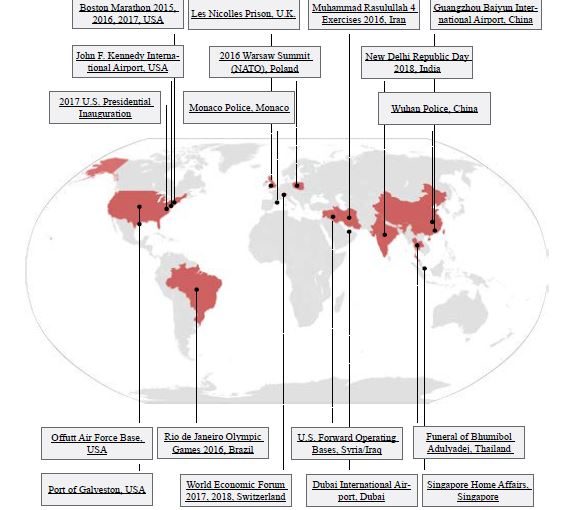The Centre for the Study of the Drone (http://dronecenter.bard.edu/publications/counter-drone-systems/) has published a new study on the counter drone market which lists at least 235 counter-drone products either on the market or under active development from 155 companies.
“The expansion of the sector in the roughly five years since counter-drone systems first appeared on the market has been stratospheric,” said the report. “In a market survey conducted in 2015, researchers at the Sandia National Laboratories identified just 10 dedicated counter-drone systems available for acquisition. Today, less than three years later, we have tallied over 200 systems on the market.”
The study found:
- At least sixty seven systems are advertised as being capable of both detection and interdiction.
- A majority of the systems, 177 in total, are designed for ground-based use. Thirty five systems are designed to be handheld, and 18 systems are mounted aboard a drone. Two systems consist of a combination of ground-based and handheld elements, while one system consists of a combination of ground-based and drone-based elements. Two products consist of projectiles designed specifically for C-UAS, and are therefore platform agnostic.
- Of the 155 systems that are capable of detection, 95 appear to employ a single sensor type, while at least 60 employ a combination of one or more sensor types.
- Roughly an equal number of systems (approximately 60) employ radar, RF detection, and EO sensors. Fifty three employ IR, while 21 systems employ an acoustic sensor.
- About half of the 147 systems capable of interdiction rely on a single technique and half rely on two or more techniques.
- Jamming (Both RF and GNSS) is the most common interdiction method among systems: 88 systems depend on some form of signal jamming alone, while an additional eight systems employ jamming along with another technique.
| C-UAS methods | Company products |
| Jamming (RF,GNSS or both | 96 |
| Net | 18 |
| Spoofing | 12 |
| Laser | 12 |
| Machine gun | 3 |
| Electromagnetic pulse | 2 |
| Water projector | 1 |
| Sacrificial collision drone | 1 |
One of the report’s more important conclusions was: “At present, there are no commercially available C-UAS systems that are capable of differentiating between peaceful and malicious drone use. In the military domain, this could also be an issue—a C-UAS system that cannot tell the difference between allied and adversary unmanned aircraft could accidentally shoot down friendly drones.”
Picture: The Centre for Study of the Drone – where C-UAS systems have been deployed in recent years




